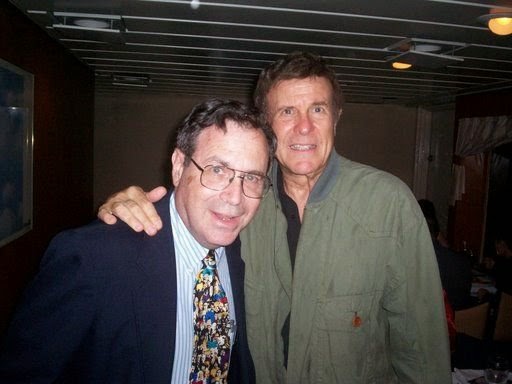I disagree with this review!!!. I enjoyed it.
==========================================================
And now for the latest heart-rending episode in Broadway's own reality soap opera, ''When Bad Shows Happen to Great Songwriters.''
If you happen to be among the masochists who make a habit of attending the entertainments called jukebox musicals, in which pop hits are beaten up by singing robots, you may think you've seen it all: the neutering of Brian Wilson and the Beach Boys in ''Good Vibrations,'' the canonizing (and shrinking) of John Lennon as a misunderstood angel-child in ''Lennon,'' and the forcible transformation of Johnny Cash from Man in Black to Sunshine Cowboy in ''Ring of Fire.''
But even these spectacles of torture with a smile, frightening though they may be, are but bagatelles compared with the systematic steamrolling of Bob Dylan that occurs in ''The Times They Are A-Changin','' which opened last night at the Brooks Atkinson Theater.
Mr. Dylan's songs have been entrusted to the great choreographer Twyla Tharp, the woman who gloriously redeemed the jukebox genre with ''Movin' Out,'' a narrative ballet set to songs by Billy Joel. Ms. Tharp is one of the bona fide, boundary-stretching geniuses of modern dance. And when a genius goes down in flames, everybody feels the burn.
Using little more than the bodies of her dancers to tell a decade-spanning story of an American working-class generation, Ms. Tharp found unexpected depths in Mr. Joel's music. Using a whole lot more scenery, props and special effects to create a circus-themed allegory of fathers and sons, Ms. Tharp single-handedly drags Mr. Dylan into the shallows.
Among epochal popular music artists of the last 50 years, no one has matched Mr. Dylan in combining a distinctive, easily identified style with an evasiveness that defies pigeonholes. Folkie, protest singer, rock'n'roller, gospel spiritualist, symbolist poet: Mr. Dylan has invited and rejected each of these labels, wriggling out of them with Houdini-like slipperiness to reinvent himself anew.
His very style of singing -- casual, almost throwaway, yet achingly intense -- provides a remarkably complete defense system against those who would parse his lyrics into one core of meaning or belief. Divorce his words from his melodies, and pretension and preciousness rear their self-conscious heads. Most of Mr. Dylan's best songs, even his full-throttle anthems of rebellion and hedonism, tingle with ambivalence, mystery and a knowing sense of the surrealism of so-called reality.
A surrealist approach would certainly seem to have been Ms. Tharp's idea for ''The Times,'' first staged at the Old Globe Theater in San Diego last winter and extensively revised since. This songbook-driven tale of Oedipal conflict is set in a traveling circus, the sinister, down-at-heel American variety portrayed in films from the 1930's and 40's like ''Freaks'' and ''Nightmare Alley.'' But with her top-drawer design team, led by Santo Loquasto (sets and costumes) and Donald Holder (lighting), Ms. Tharp pushes the atmosphere into the phantasmagorical luridness of Fellini, with a splash of Bergmanesque darkness for shivery spice.
Sounds tantalizing, huh? The program indicates that the setting is ''Sometime between awake and asleep,'' and if Ms. Tharp had seen fit simply to keep us wandering through a shifting dreamscape, set to Mr. Dylan's music, ''The Times'' might have passed muster as a really cool head trip for unregenerate hippies in search of natural highs. This would also have allowed each Dylan fan to bring his or her own interpretation to the murky goings-on, no doubt inspiring heated postperformance debates. (''No, man, don't you see, what the little dog stands for is purity!'')
But Ms. Tharp is a precisionist in all things, and she brings to her storytelling the same exacting discipline that informs her choreography. Metaphoric images, which float miragelike when heard in song, are nailed down with literal visual equivalents. And highlights of the Dylan repertory (from ''Mr. Tambourine Man'' to ''Knockin' on Heaven's Door'') take the place of plot-propelling dialogue.
In a show like ''Mamma Mia!'' (the Abba musical) this device can be kind of a hoot. But as you might expect of Ms. Tharp, this lady's not for hooting.
The story -- or fable, as Ms. Tharp prefers to call it -- is about a creepy tyrant named Captain Ahrab (Thom Sesma, who does indeed suggest Melville by way of Tim Burton) who rules over his traveling circus with a bullwhip. His employees include a whole passel of clowns, a lovely female runaway named Cleo (Lisa Brescia) and Ahrab's son, Coyote (Michael Arden), who has the clean-scrubbed look of a sensitive high school sports star.
Will the idealistic Coyote take up his father's whip to exploit the leadership-hungry clowns? Will he steal Cleo from Dad? Will he create a more benign world order? Hint: The show begins with Coyote looking soulfully into the audience to intone, with ominousness and dewy hope, ''The Times They Are A-Changin'.''
The three principals share most of the major singing, through which we learn of both father's and son's feelings for Cleo (via a duet version of ''Just Like a Woman'') and of Cleo's lonely wistfulness (''Don't Think Twice, It's All Right'').
Ahrab's cynical huckster's world view is conveyed by his growling through numbers like ''Desolation Row'' and ''Highway 61 Revisited.''
In contrast, Coyote wonders ''how many roads must a man walk down, before you call him a man,'' and Cleo senses a kindred spirit in the lad. Coyote is soon shyly proposing to Cleo that she ''lay, lady, lay, lay across my big brass bed.'' (That I stifled a groan at this point should be honored as an act of heroic restraint.) In the meantime, the clowns are growing restless and rebel against their cruel master, who is destined to find himself ''knock, knock, knockin' on heaven's door.''
Are you still with me, brave reader? Ms. Tharp turns lyrics' metaphors not only into flesh but also into flashlights, jump-ropes, stuffed animals and new brooms that sweep clean. (If there was a kitchen sink onstage, I missed it, which isn't to say it wasn't there.) Props rule in this magic kingdom, along with charadelike annotations of images.
Just mention, say, Cinderella in ''Desolation Row,'' and there she is, center stage. When the same song refers to Dr. Filth, there he is performing surgery (on a truly amazing contortionist who provides the show with its single most disturbing image).
When Ahrab breaks his son's jeweled Cubist guitar, which he has been playing so spiritedly for ''Like a Rolling Stone,'' the mournful Cleo freezes the moment by singing ''Everything Is Broken.'' And as hedonism acquires mortal shadows in ''Mr. Tambourine Man,'' who should show up but a group of black-hooded dancers straight out of Ingmar Bergman's ''Seventh Seal.''
Of the three soloists, Mr. Arden comes closest to finding a compromise between Dylanesque twang and hearty melodiousness. But all the leading players suffer from being stranded between character and allegory. (I kept thinking of the woman in Christopher Durang's parody of Sam Shepard who looked proudly at her son and said, ''I gave birth to a symbol -- and me with no college education.'')
Perversely, the songs seem to become more abstract -- and more fixed in their metaphysical meanings -- from being linked with individual characters. The orchestrations (by Michael Dansicker and Mr. Dylan) are often evocative of the original Dylan recordings, but I will say that this is the first time that it ever occurred to me that ''Rainy Day Women No. 12 and 35'' could sound, in an instrumental bridge, like ''The Trolley Song.''
The corps de clowns includes the extraordinary John Selya, who dazzled in ''Movin' Out,'' as the circus strongman and leader of the clown rebellion. But while Mr. Selya looks as buff and agile as ever, he doesn't get much chance to strut his kinetic stuff. There are a few glorious passages of Ms. Tharp's signature, tight-muscled choreography, in which angular body tension becomes its own philosophical statement, an expression of raw existential frustration.
Mostly, though, Ms. Tharp concentrates on stylish variations on circus stunts -- including stilt walking, tumbling and tightrope walking -- some of them truly jaw-dropping. A trampolinelike surface has been built into the stage, allowing the dancers to appear to levitate.
But if the choreography at times defies gravity, the show itself may be the most earthbound work Ms. Tharp has produced. Even as the dancers seem to fly, Mr. Dylan's lyrics are hammered, one by one, into the ground.
The Times They Are A-Changin'
Conceived by Twyla Tharp; music and lyrics by Bob Dylan; directed and choreographed by Ms. Tharp; music arranged, adapted and supervised by Michael Dansicker; sets and costumes by Santo Loquasto; lighting by Donald Holder; sound by Peter Hylenski; orchestrations by Mr. Dansicker and Mr. Dylan; music director, Henry Aronson; music coordinator, Howard Joines; technical supervisor, Smitty; production stage manager, Arthur Gaffin; associate producers, Jesse Huot, Ginger Montel and Rhoda Mayerson; general manager, the Charlotte Wilcox Company. Presented by James L. Nederlander; Hal Luftig and Warren Trepp; Debra Black; East of Doheny; Rick Steiner/Mayerson Bell Staton Group; Terry Allen Kramer; Patrick Catullo; and Jon B. Platt and Roland Sturm. At the Brooks Atkinson Theater, 256 West 47th Street; (212) 307-4100. Running time: 1 hour, 30 minutes.
WITH: Michael Arden (Coyote), Thom Sesma (Captain Ahrab), Lisa Brescia (Cleo) and Lisa Gajda, Neil Haskell, Jason McDole, Charlie Neshyba-Hodges, Jonathan Nosan, John Selya and Ron Todorowski (the Ensemble).
URL: http://www.nytimes.com
GRAPHIC: Photos: The Times They Are A-Changin' -- Michael Arden as the son of a creepy ringmaster in the Twyla Tharp musical with music by Bob Dylan at the Brooks Atkinson Theater. (Photo by Sara Krulwich/The New York Times)(pg. E1)
Going to the carnival: Thom Sesma, center, as the tyrannical Captain Ahrab in ''The Times They Are A-Changin' '' at the Brooks Atkinson. (Photo by Sara Krulwich/The New York Times)(pg. E2)
LOAD-DATE: October 27, 2006







